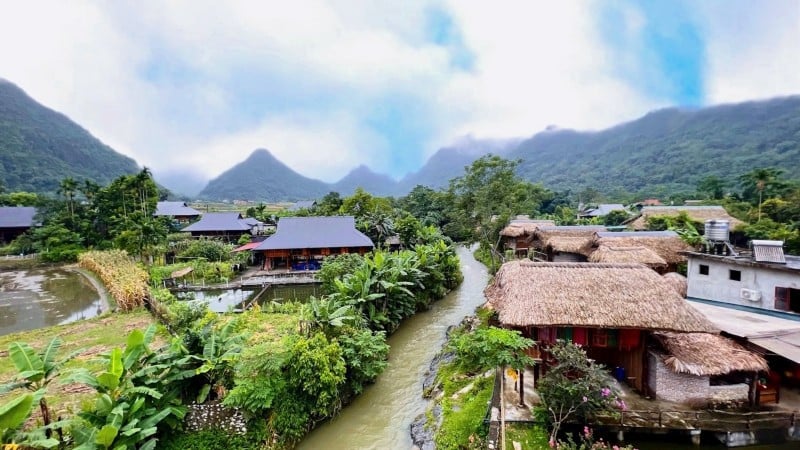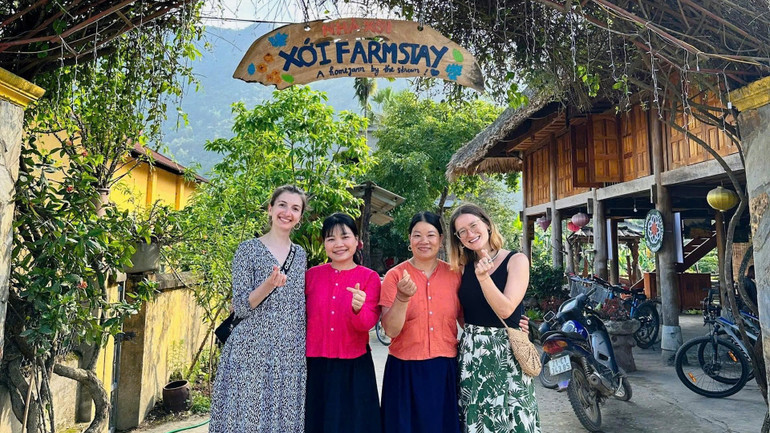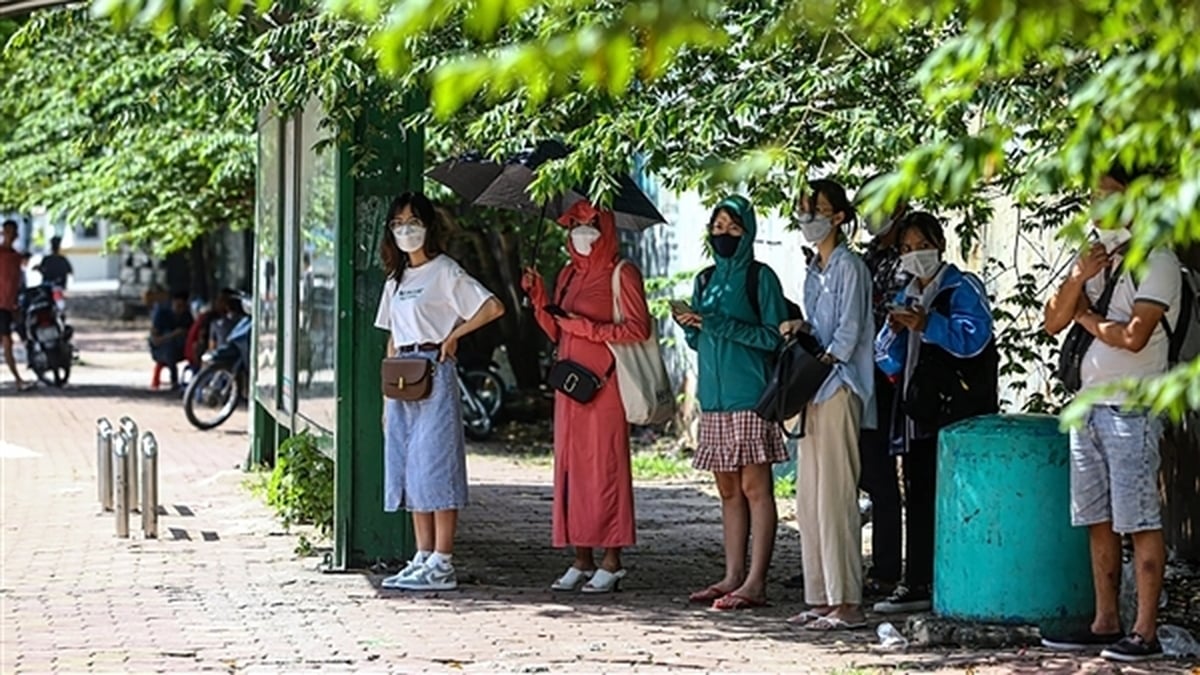
A young generation like Hoang Thi Xoi - a Tay girl born in 1992, went far away to learn a lot and then returned to start a business in her childhood home, connecting the community to do sustainable tourism, honoring agricultural values and indigenous culture.
Keeping the Tay culture flowing
After about 5 hours of traveling from Hanoi , we arrived at Xoi Farmstay in Tong Ping Cai village, Lam Thuong commune on a day in June. While welcoming guests and closely following the construction of a new house, the owner Hoang Thi Xoi was always busy but still smiling brightly. The space of the stilt house here is simple but neat: clean tables and chairs, tea and water ready, every corner is decorated with flowers growing around the garden. The fatigue of the long journey seemed to disappear when Xoi's mother and sister prepared a tray to invite guests: fragrant white rice from newly milled rice, stir-fried water spinach with garlic, cu sausage, bamboo shoot soup... all rustic dishes of the Tay people.
The Tay women are charming in their traditional costumes, although their everyday outfits are quite simple, consisting of colorful short-sleeved shirts and simple skirts for working. But I also see them in their festival costumes in beautiful framed photos hanging on the walls of their houses. They are hand-woven indigo-dyed ao dai, headscarves, and sparkling silver bracelets - all handmade and passed down through the generations.
What woke us up in the middle of Lam Thuong valley was not the sound of a clock, but the sound of a stream and birds singing. Next to the porch of the stilt house, the Khuoi Noi stream murmured and meandered at the foot of the hill. In the Tay language, “khuoi” means stream, “noi” means small, to distinguish it from Khuoi Luong - a larger stream. The two streams met, forming a source that nourished the village. With a group of tourists, I cycled across the rice fields, stopped at a lotus pond in full bloom, then stopped to cool off under the Nam Chan waterfall during the water pouring season.
Summer here is like a symphony of the sound of trickling water, the chirping of cicadas, and the sound of children's footsteps playing together. The cycling path through the villages of Tong Ping Cai, Tong Pang, and Kheo Leng... takes visitors along rice fields, banana gardens, vegetable fields, lotus ponds, interspersed with ancient stilt houses and green corn fields. Besides the vibrant nature, culture is the core value. Each place has a meaningful name: Tong Ping Cai is "flat lychee field", Tong Pang is "pang tree field" - the naming is associated with the pristine vegetation when the ancient Tay people reclaimed the land and established the village, creating a vivid map of memories. About 80% of the households here still maintain the traditional wooden stilt houses, in front of each house there is a fish pond and green trees. Some houses have been renovated, roofed with corrugated iron, upgraded with amenities but still retain the old structure...
It can be said that the landscape here is not only aesthetic but also a resource, a form of “shareable identity”. It is present in the way food is presented, the way people greet each other and passersby. Children grow up in nature, learning to grow vegetables, folk tales, English, and playing the Tinh (tinh tau)… One of the favorite experiences is making Tay hats.
Artisan Hoang Thi Hue in Tong Pang village, who used to worry about her profession being lost, is now busy instructing tourists on how to weave rims, attach palm leaves, and meticulously sew brocade straps. Conical hats are now not only a means of protection from the sun and rain, but also a souvenir, a performance prop, a decoration that carries the local soul. Visitors come here not only to rest, but to live with the village. They cycle to explore , follow the villagers to harvest rice, go into the forest to pick vegetables, listen to Then singing under the stilt houses, learn how to make Tay conical hats, make wooden flower vases, etc. Ms. Hue said: "In the past, making hats was just for wearing, but now it makes tourists happy. Tay conical hats have become a gift from the countryside that can be taken to many faraway places."
Lam Thuong is gradually becoming a name sought after by many tourists in big cities in the country and international tourists. Not noisy, not bustling, but quietly spreading with the honest beauty of the village and its people. In autumn, Lam Thuong wears a golden coat of ripe rice mixed with the green of the mountains and forests. In winter, the mist hangs, the village is like a watercolor painting, where the breath of the mountains and forests permeates each indigo shirt of the Tay people, each palm-leaf roofed house is as beautiful as a fairy tale. Nam Chan and Na Ken waterfalls pour white water, Tham Duong and Bo Kheo caves invite exploration...
Staying with the locals, every evening visitors are invited to attend cultural festivals with Then singing, Tinh lute, conical hat dancing, and scarf dancing. On festival days, the whole village comes together to join in the fun, light a campfire, and tell old stories. The children are excited, the elderly are moved to tears... when their ethnic culture is not only preserved but also cherished and spreads far and wide every day.

Green shoots of the village
According to Mr. Hoang Duy Than, head of Tong Ping Cai village, the Xoi family farmstay is a pioneering model of community tourism development in the locality, contributing to creating jobs for local people and actively promoting the image of the village and Tay culture. “Ms. Xoi is a typical example of a studious young person who returned to Tong Ping Cai to enrich her homeland. She does community tourism very systematically and also guides and motivates many other families in the area to develop their economy from tourism,” said Mr. Than.
Hoang Thi Xoi was born and raised in Tong Pinh Cai village. She loved and was good at foreign languages since she was young, so she studied tourism and worked as a tour guide specializing in bringing international guests. After traveling all over the country and abroad, one day, Xoi returned home with 50 million VND as capital to renovate her family's old stilt house into a place to welcome guests.
At first, no one believed that a remote area like Lam Thuong, which was once obscure and considered a “dead-end”, would have visitors. But Xoi saw and believed in things that few people paid attention to: a small stream full of water all year round, a waterfall in the middle of the old forest, a peaceful village like a picture and a treasure trove of Tay culture that needed to be “told” properly. The young girl taught herself and did everything from scratch, from designing the house, learning about farmstay models everywhere, and promoting it on social networks.
“I also made flyers and posted them in some restaurants in Hanoi's Old Quarter, hoping as many people as possible would see them,” Xoi said.
From a shared stilt house in 2017, Xoi Farmstay has now expanded into 5 separate stilt houses, a spacious communal house, accommodating up to 50 guests/day, creating jobs for 20 local workers, dozens of others benefiting from food services, trekking, handicraft workshops... On Google, Xoi Farmstay scored 4.9/5 points; on Booking it was 9.8/10 - a dream number for every tourist facility in the digital age. What makes visitors remember forever is not only the beautiful scenery but also the warm welcome.
“Xoi and her family made us feel like family, not paying guests. I saw the vegetables grown in the garden, the food was delicious, and the scenery was breathtaking,” wrote Lisa Torres (USA) on TripAdvisor.
And Xoi is not alone. Other models such as Moc Farmstay in Kheo Leng village, Jack Ecodge of young man Hoang Trong Giac, Mrs. Hoang Thi Sinh's family in Chang Pong village, Mr. Tang Viet Dung's family in Nam Chan village... were formed one after another. Each person has their own way of doing things, but they share the same spirit of preserving culture and doing decent tourism. No one doubts anymore "What is there to do tourism here?", the people in the area are now used to meeting international guests, some know English, some open coffee shops, but they do not lose their sincerity and friendliness.
During the low season, Xoi Farmstay does not waste resources. Xoi and other mothers and sisters in the village learn to livestream to sell local agricultural products: upland rice, dried bamboo shoots, fruits, herbal shampoos, wooden and stone vases... She also connects with young people in many other rural areas, who also "leave the city" for the forest and the sea to research and produce products based on the advantages of their homeland. To closely link tourism with agriculture and create a sustainable direction, they become a network of mutual support, creating a green startup community.
The story of Hoang Thi Xoi in Lam Thuong reminds us of the family of Vang Thi Thong in Lien village (Bac Ha, Lao Cai). This land of the Tay people has just created a fever of discovery through the reality TV show “Haha Family”, when many famous entertainment artists came to live and work with the people. Both places prove that: in a digitalized and increasingly developing society, identity is always the most valuable asset, without needing to be embellished. Then singing - Tinh lute, festivals, handmade costumes... are still present in everyday life and are especially more beautiful when visitors come.
What is admirable is that tourism here does not follow the crowd, nor is it concreted in the modern race. The forest is still green, the stream is still clear, the rice fields are still ripe at the foot of the mountain. The identity exists completely in each house, lifestyle, song, and grain of rice.
Source: https://nhandan.vn/mua-xanh-o-thung-lung-lam-thuong-post893270.html




































































































Comment (0)